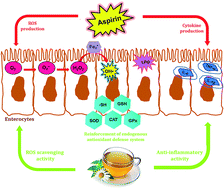HPLC/PDA/ESI-MS/MS analysis of chamomile decoction and mechanism of its protective effects on aspirin-induced small bowel injuries
Abstract
The aim of the present study is to evaluate the effect of chamomile (Matricaria recutita L.) decoction extract (CDE) on aspirin-induced small bowel injuries. The chemical composition of CDE was analysed by LC-HRESIMS. Experimental animals received CDE (100 mg kg−1, p.o. P.C.) before induction of intestinal injuries by oral aspirin administration. Chromatographic analysis has allowed the identification of 15 phenolic compounds, especially phenolic acids and flavonoids. The intestinal disturbances were assessed by histopathological and biochemical examinations. In vivo, we found that aspirin administration caused intestinal histological alterations accompanied by an oxidative stress status as assessed by increase in a lipoperoxidation and depletion of non-enzymatic antioxidant levels and antioxidant enzyme activities, as well as an intestinal overload of reactive oxygen species such as H2O2, OH˙ and O2˙−. We also showed that aspirin treatment significantly increased the pro-inflammatory mediator (IL-6, IL-1β and TNF-α) levels in plasma. CDE treatment suppressed all the histological and biochemical disturbances induced by aspirin intoxication.



 Please wait while we load your content...
Please wait while we load your content...